SUBFAMILY PROCERATIINAE
Genus Proceratium
| The Ants of
Africa SUBFAMILY PROCERATIINAE Genus Proceratium |
|
| Contents - Proceratiinae - PROCERATIINAE Introduction |
In Tribe PROCERATIINI.
Diagnostic Features - Tergite of second gastral tergite
strongly vaulted so that the remaining segments point anteriorly.
Alitrunk devoid of sutures. Mandibles with three or more teeth, not
overhung by the clypeus. Apical segment of the antenna moderately
enlarged but not bulbous. Roger's (1863a) genus definition is at ![]() . Proceratium,
junior synonym Sysphincta (Brown, in Borgmeier, 1957: 118).
. Proceratium,
junior synonym Sysphincta (Brown, in Borgmeier, 1957: 118).
Bolton (1973a) mentions a single, unnamed, West African species, known only from rotten wood in Ghana. Members elsewhere normally prey on the eggs of arthropods (Hölldobler and Wilson (1990, pages 224, 565).
The genus was revised by Baroni Urbane & De Andrade (2003). The
parts relevant to species known from sub-Saharan Africa are at, pp
59-62, ![]() . and, pp 282-305,
. and, pp 282-305, ![]() . Unfortunately, the
illustrations they gave were mostly monochrome SEM images and have not
scanned well [Baroni Urbani, C. and M. L. De Andrade. 2003. The ant
genus Proceratium in the extant and fossil record (Hymenoptera:
Formicidae). Museo Regionale di Scienze Naturali, Monografie, 36,
1-480]
. Unfortunately, the
illustrations they gave were mostly monochrome SEM images and have not
scanned well [Baroni Urbani, C. and M. L. De Andrade. 2003. The ant
genus Proceratium in the extant and fossil record (Hymenoptera:
Formicidae). Museo Regionale di Scienze Naturali, Monografie, 36,
1-480]
Key to Afrotropical species, developed from Terron (1981) - ![]() .
.
| 1 | 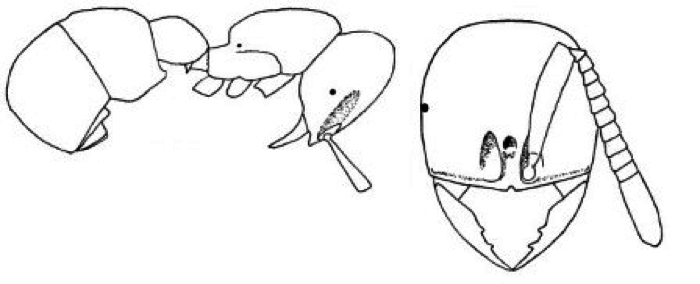 Clypeus projecting
forwards of the frontal carinae, with
the anterior border notched; TL 2.7 mm; overall coarsely and regularly
punctate; covered with dense golden pubescence, particularly visible on
second gastral segment; black, appendages and clypeus brown Clypeus projecting
forwards of the frontal carinae, with
the anterior border notched; TL 2.7 mm; overall coarsely and regularly
punctate; covered with dense golden pubescence, particularly visible on
second gastral segment; black, appendages and clypeus brown |
. |
| <. | 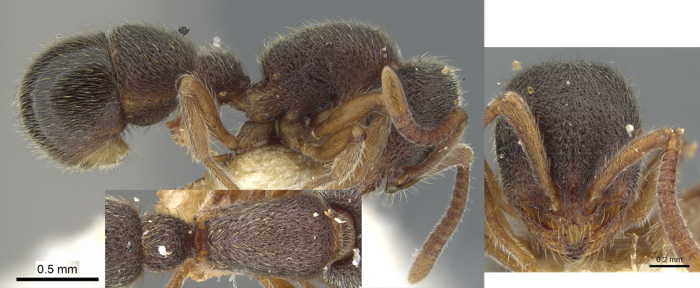 |
Ghana - boltoni |
| -- | Clypeus in dorsal view not or only slightly projecting forwards of the frontal carinae, border entire | 2 |
| 2 | Eyes well developed with 8 or 25 ommatidia | 3 |
| -- | Eyes with no more than one ommatidia or absent | 4 |
| 3 |  Eyes well developed
with about 25 ommatidia, also a well
developed median ocellus; TL ca 3 mm; sculpturation of head granulose,
similar but finer on the alitrunk and gaster, latter weakly shiny;
overall covered with minute whitish pubescence; ferruginous, region of
ocelli browner, propodeal margins black; seemingly Baroni Urbani and De
Andrade Eyes well developed
with about 25 ommatidia, also a well
developed median ocellus; TL ca 3 mm; sculpturation of head granulose,
similar but finer on the alitrunk and gaster, latter weakly shiny;
overall covered with minute whitish pubescence; ferruginous, region of
ocelli browner, propodeal margins black; seemingly Baroni Urbani and De
Andrade |
Kenya - toschii |
| -- | 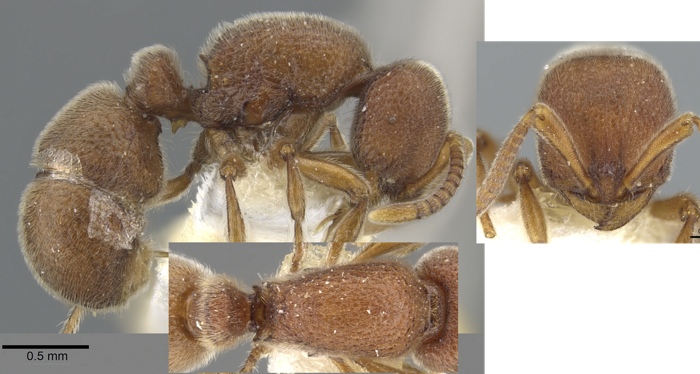 Eyes with about 8 ommatidia but no obvious
ocelli; integumental foveae small, gaster with superficial sculpture Eyes with about 8 ommatidia but no obvious
ocelli; integumental foveae small, gaster with superficial sculpture |
Burundi - burundense |
| 4 | 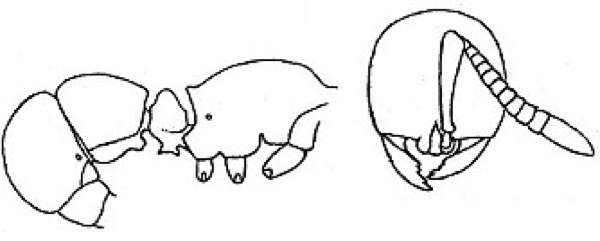 Eyes absent; second
segment of gaster shorter than the
first; TL 2.3 mm; overall sculpturation dense fine puncturation;
pubescence reduced and whitish; yellow red Eyes absent; second
segment of gaster shorter than the
first; TL 2.3 mm; overall sculpturation dense fine puncturation;
pubescence reduced and whitish; yellow red |
. |
| . | 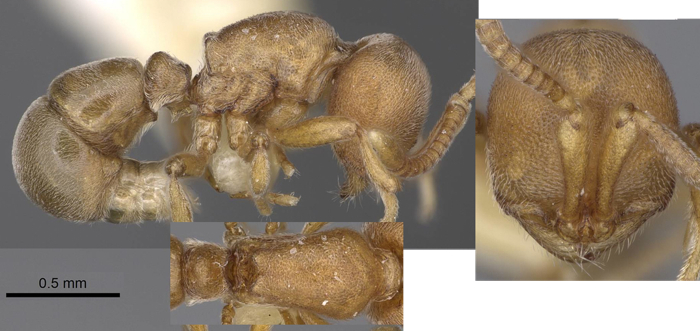 |
as coecum in Terron key - Cameroun - terroni |
| -- | Eyes reduced but visible | 5 |
| 5 | 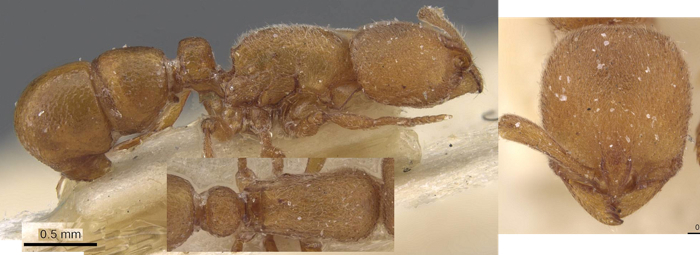 With no more than superficial
foveae; apex of frontal carinae rounded; second segment of gaster about
1.2 X longer than first; TL 3 mm; reddish-yellow, margins of frontal
carinae and propodeal teeth piceous; covered all over with dense
yellowish-white pubescence, longest on the gaster With no more than superficial
foveae; apex of frontal carinae rounded; second segment of gaster about
1.2 X longer than first; TL 3 mm; reddish-yellow, margins of frontal
carinae and propodeal teeth piceous; covered all over with dense
yellowish-white pubescence, longest on the gaster |
Zimbabwe - arnoldi |
| -- | 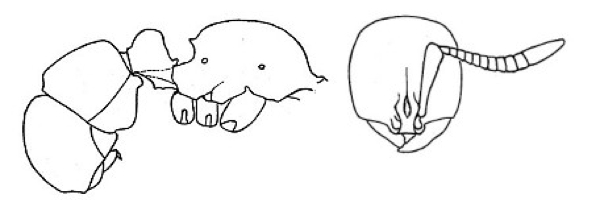 Foveae all deep;
second segment of gaster about the same
length as the first; apex of frontal carinae angular; dark
yellow-brown, appendages and apex of gaster yellower; integumental
foveae large & deep, gaster with deep sculpture Foveae all deep;
second segment of gaster about the same
length as the first; apex of frontal carinae angular; dark
yellow-brown, appendages and apex of gaster yellower; integumental
foveae large & deep, gaster with deep sculpture |
. |
| . | 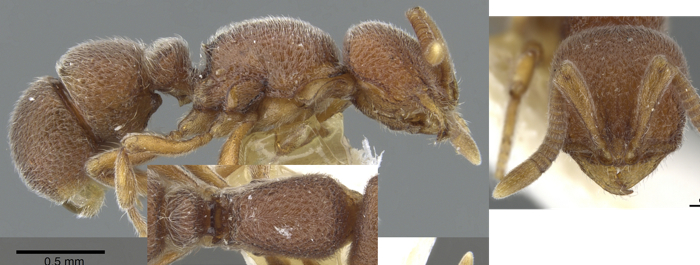 |
Cameroun - lunatum |
| PONERINAE Introduction |
© 2007, 2008, 2009, 2012, 2014 - Brian Taylor CBiol
FSB FRES 11, Grazingfield, Wilford, Nottingham, NG11 7FN, U.K. |
href="proceratium.htm"